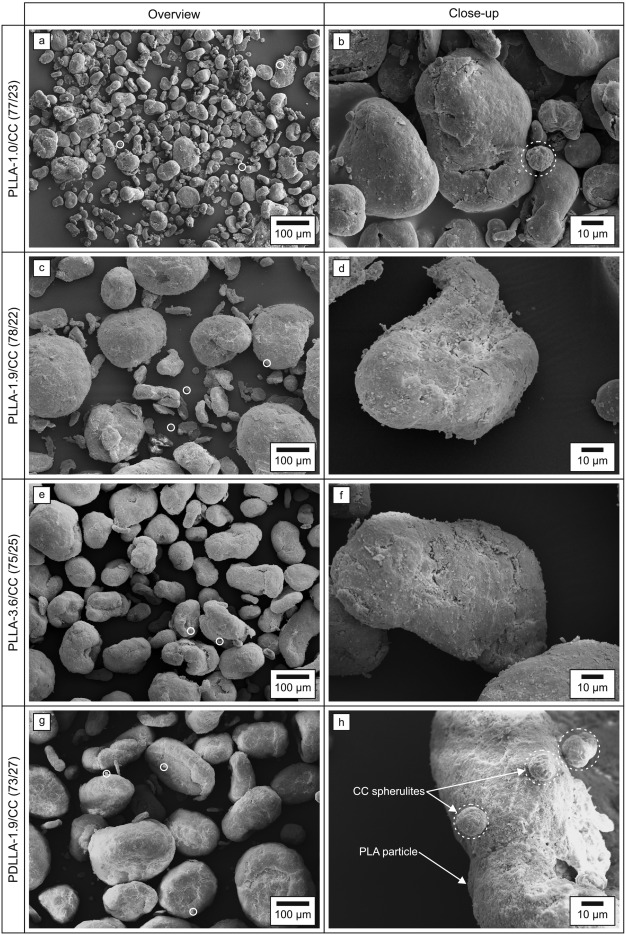PLLA Calcium Carbonate SLS 3D Printing Powders Evaluated for Bone Tissue Scaffolds

Particle size distributions of the PLA/CC composite powders: (a) volumetric and (b) corresponding cumulative distributions as determined by laser diffraction analysis. The PLLA-1.0-based composite had the smallest particle size (d50 = 53 μm), whereas the amorphous PDLLA-1.9-based composite had the largest particle size (d50 = 130 μm).
Healing large bone defects is an ongoing challenge, and scientists continue to look for ways to do so in tissue engineering. With 3D printing, however, the use of solvents is often necessary. In ‘Development of a solvent-free polylactide/calcium carbonate composite for selective laser sintering of bone tissue engineering scaffolds,’ researchers from all over Germany explore alternatives.
Scientists are often enticed by selective laser sintering (SLS) 3D printing for bioprinting, but solvents are often required. The technology is suitable for creating complex structures to encourage bone growth, and there are methods already being used with both titanium and polyetherketoneketone (PEKK) implants. The obstacle is, however, that such implants stay in the patient’s body. This could cause problems later, and especially due to any exposure to chemicals. There are biodegradable & biocompatible options available though, and here the researchers learned more about them, along with creating a polylactide/calcium carbonate composite powder for SLS. The team experimented with four different composite powders, and four different grades of polylactide.
“Among the biodegradable polymers, polylactide (PLA) has the highest mechanical strength (i.e., tensile strength of approx. 50–70 MPa, tensile modulus of 3000–4000 MPa, flexural strength of 100 MPa, and flexural modulus of 4000–5000 MPa,” state the researchers in their paper. “Thus, PLA is of particular interest for bone tissue engineering. However, it should be noted that the high strength comes at the expense of a low elongation at break of 2–10%, which shows that PLA is quite brittle.”

Scanning electron microscope images of the polylactide (PLA)/calcium carbonate (CC) composite powder particles [63]. The PLLA-1.0 with the lowest inherent viscosity of 1 dl/g could be ground to the smallest particle size. Some intact CC spherulites are marked by white circles to show that they were present in each composite.
“Therefore, upscaling and medical approval are complicated,” state the researchers.
Viscosity is another issue the researchers had to tackle:
“As the melt viscosity strongly increases with polymer chain length or molecular weight, we hypothesize that a careful selection of the inherent viscosity (which is a measure for the molecular weight) can improve processability.”
The scientific team used a customized Formiga 3D printer for fabricating a patient-specific implant demonstrator. It featured a build envelope of 60 × 75 × 120 mm. Experiments were as follows:
- Single layer
- Rectangular specimens for analysis of micro-porosity and cell viability
- Circular specimens for mechanical strength evaluation
- Patient-specific implant demonstrator
- Micro-porosity analysis
- Cell viability assay
- Mechanical strength testing
Overall, the researchers found that SLS test specimens did demonstrate good cell compatibility with MG-63 osteoblast-like cells. They concluded further:
“In the future, such structures could be used as medical devices to promote the healing of critical size bone defects in craniomaxillofacial surgery. In addition, the scaffolds could be seeded with cells in the context of bone tissue engineering. The next steps towards these goals will include further in vitro and in vivo experiments to evaluate the biocompatibility and degradation behavior of the developed materials and scaffolds.”
Amazingly, tissue engineering is becoming almost commonplace in the 3D printing world. And while scientists and bioengineers have created everything from 3D printed brain tumors for use as medical models to bioprinted lungs and liver tissue, the true pinnacle will be the fabrication of human organs. Find out more about bone tissue engineering here. What do you think of this news? Let us know your thoughts! Join the discussion of this and other 3D printing topics at 3DPrintBoard.com.

Light microscope images of single-layer surfaces after laser exposure. Identical process parameters (i.e., the same laser power, hatch distance, scan speed, and laser beam diameter) were used for all composite materials. The scan tracks were oriented horizontally and the exposure started at the top [schematically visualized in (g)]. The dashed lines indicate a continuous melt track or melt droplets. The PLLA-1.0-based composite showed the best melting behavior because it formed continuous melt tracks instead of melt droplets and did not discolor. Thus, it was selected for further investigation.
Subscribe to Our Email Newsletter
Stay up-to-date on all the latest news from the 3D printing industry and receive information and offers from third party vendors.
Print Services
You May Also Like
RAPID 2025: Stratasys & trinckle Announce Strategic Software Partnership
News continues to flood in from last week’s RAPID+TCT 2025, including a new partnership between AM market leader Stratasys and Berlin-based software company trinckle. By automating important steps in fixture...
RAPID TCT 2025: Spring in the Paris of the Midwest
I’m going to go out on a limb here and say that whomever coined the phrase Detroit: Paris of the Midwest, had not spent a lot of time in Paris...
3D Printing Financials: 3D Systems Looks to Bounce Back in 2025
After a challenging year for the industry, 3D Systems (NYSE: DDD) ended 2024 with results pointing to a reset, laying the groundwork for future profitability. The company didn’t post strong...
Printing Money Episode 27: Q4 2024 Public 3D Printing Earnings Review with Troy Jensen, Cantor Fitzgerald
Q2 2025 has already begun, but public markets reporting has only just finished with Q4 2024. To tie a bow on Q4 2024, we are thankful to have Troy Jensen...

























